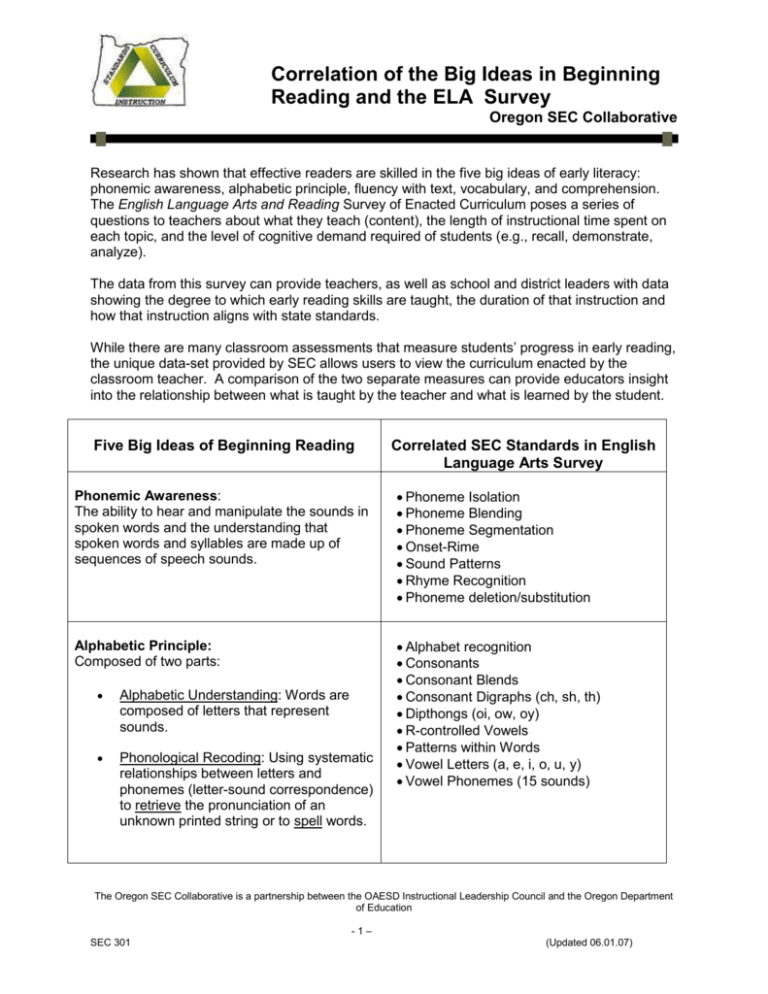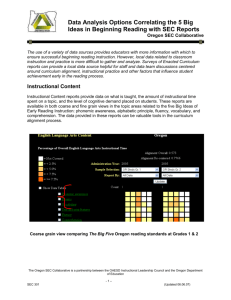Correlation of the Big Ideas in Beginning Reading and the ELA Survey
advertisement

Correlation of the Big Ideas in Beginning Reading and the ELA Survey Oregon SEC Collaborative Research has shown that effective readers are skilled in the five big ideas of early literacy: phonemic awareness, alphabetic principle, fluency with text, vocabulary, and comprehension. The English Language Arts and Reading Survey of Enacted Curriculum poses a series of questions to teachers about what they teach (content), the length of instructional time spent on each topic, and the level of cognitive demand required of students (e.g., recall, demonstrate, analyze). The data from this survey can provide teachers, as well as school and district leaders with data showing the degree to which early reading skills are taught, the duration of that instruction and how that instruction aligns with state standards. While there are many classroom assessments that measure students’ progress in early reading, the unique data-set provided by SEC allows users to view the curriculum enacted by the classroom teacher. A comparison of the two separate measures can provide educators insight into the relationship between what is taught by the teacher and what is learned by the student. Five Big Ideas of Beginning Reading Correlated SEC Standards in English Language Arts Survey Phonemic Awareness: The ability to hear and manipulate the sounds in spoken words and the understanding that spoken words and syllables are made up of sequences of speech sounds. Phoneme Isolation Phoneme Blending Phoneme Segmentation Onset-Rime Sound Patterns Rhyme Recognition Phoneme deletion/substitution Alphabetic Principle: Composed of two parts: Alphabet recognition Consonants Consonant Blends Consonant Digraphs (ch, sh, th) Dipthongs (oi, ow, oy) R-controlled Vowels Patterns within Words Vowel Letters (a, e, i, o, u, y) Vowel Phonemes (15 sounds) Alphabetic Understanding: Words are composed of letters that represent sounds. Phonological Recoding: Using systematic relationships between letters and phonemes (letter-sound correspondence) to retrieve the pronunciation of an unknown printed string or to spell words. The Oregon SEC Collaborative is a partnership between the OAESD Instructional Leadership Council and the Oregon Department of Education -1– SEC 301 (Updated 06.01.07) Correlation of the Big Ideas in Beginning Reading and the ELA Survey Oregon SEC Collaborative Fluency: Reading words with no noticeable cognitive or mental effort (automaticity). It is having mastered word recognition skills to the point of overlearning. Fundamental skills are so "automatic" that they do not require conscious attention. Prosody (phrasing, intonation, inflection) Automaticity of words and phrases Speed/Pace Accuracy Vocabulary: Learners must have access to the meanings of words to guide them into contemplating known concepts in novel ways (i.e. to learn something new). Expressive Vocabulary: Requires a speaker or writer to produce a specific label for a particular meaning. Compound words and contractions Inflectional forms (-s, -ed, -ing) Suffixes, prefixes, and root words Word definitions (including new vocabulary) Synonyms and Antonyms Word or phrase meaning from context Receptive Vocabulary: Requires a reader to associate a specific meaning with a given label as in reading or listening. Comprehension: The complex cognitive process involving the intentional interaction between reader and text to extract meaning. The essence of reading Active and intentional thinking in which the meaning is constructed through interactions between the test and the reader (Durkin, 1973) Word meaning from context Phrase Sentence Paragraph Main ideas, Key concepts Narrative elements (events, characters, setting, plot) Text features (index, fonts, glossary) Graphics (images, illustrations) Expository elements (lists, description, explanation) Technical elements (bullets, instructions, sidebars) Electronic elements (hypertext links, color) Strategies (question, infer, visualize) Metacognitive process (reflecting about one’s process) Self-correction strategies (fix-up, cueing, monitoring) Fact and opinion The Oregon SEC Collaborative is a partnership between the OAESD Instructional Leadership Council and the Oregon Department of Education -2– SEC 301 (Updated 06.01.07)









